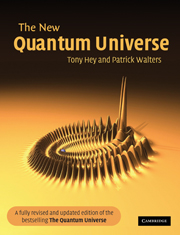Book contents
- Frontmatter
- Contents
- Preface
- Prologue
- Route map
- 1 Waves versus particles
- 2 Heisenberg and uncertainty
- 3 Schrödinger and matter waves
- 4 Atoms and nuclei
- 5 Quantum tunnelling
- 6 Pauli and the elements
- 7 Quantum co-operation and superfluids
- 8 Quantum jumps
- 9 Quantum engineering
- 10 Death of a star
- 11 Feynman rules
- 12 Weak photons and strong glue
- 13 Afterword – quantum physics and science fiction
- Epilogue
- Appendix 1 The size of things
- Appendix 2 Solving the Schrödinger equation
- Glossary
- Quotations and sources
- Suggestions for further reading
- Photo-credits
- Name index
- Subject index
Appendix 2 - Solving the Schrödinger equation
Published online by Cambridge University Press: 05 October 2013
- Frontmatter
- Contents
- Preface
- Prologue
- Route map
- 1 Waves versus particles
- 2 Heisenberg and uncertainty
- 3 Schrödinger and matter waves
- 4 Atoms and nuclei
- 5 Quantum tunnelling
- 6 Pauli and the elements
- 7 Quantum co-operation and superfluids
- 8 Quantum jumps
- 9 Quantum engineering
- 10 Death of a star
- 11 Feynman rules
- 12 Weak photons and strong glue
- 13 Afterword – quantum physics and science fiction
- Epilogue
- Appendix 1 The size of things
- Appendix 2 Solving the Schrödinger equation
- Glossary
- Quotations and sources
- Suggestions for further reading
- Photo-credits
- Name index
- Subject index
Summary
This appendix is intended for readers with some knowledge of calculus – mainly how to differentiate and integrate sines and cosines. We consider the problem of finding the quantum probability amplitudes for a particle ‘in a box’. This involves solving the Schrödinger equation for a particle of some energy E, confined to a certain region by an electrical potential V:
We consider the case where the electron can only move in one space dimension, rather than in three dimensions as in real life. In spite of the apparent artificiality of this situation, this example illustrates many of the features that occur in more realistic problems. A straightforward three-dimensional generalization of this example can be used to illustrate many features of the quantum physics not only of electrons in a metal, but also of neutrons and protons in the nucleus.
The one-dimensional box potential is shown in Fig. 4.8. Outside the box the potential is assumed to be infinitely high so that there is no probability of finding the particle in these regions. The particle is constrained to be within the box, i.e. the quantum amplitude can only be non-zero between x = 0 and x = L, the two ends of the box. Inside this region, the particle can move freely: in other words, the quantum amplitude for the particle in the box is determined by the Schrödinger equation with no potential term:
To see what form of solution is allowed, we first ‘tidy up’ the equation by introducing the new variable k:
In terms of k, the Schrödinger equation for the particle in the box now reads: which shows the mathematical structure more clearly.
- Type
- Chapter
- Information
- The New Quantum Universe , pp. 320 - 322Publisher: Cambridge University PressPrint publication year: 2003



